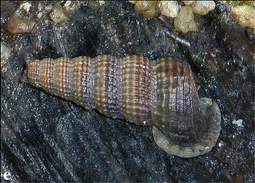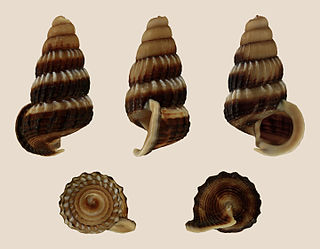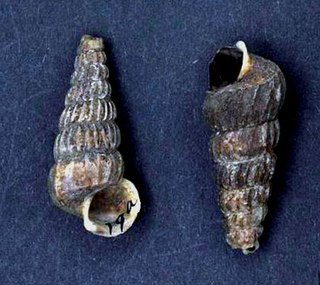Description
| | This section is empty.You can help by adding to it.(May 2010) |
| Cerithidea anticipata | |
|---|---|
| Scientific classification | |
| Kingdom: | |
| Phylum: | |
| Class: | |
| (unranked): | |
| Superfamily: | |
| Family: | |
| Genus: | |
| Species: | C. anticipata |
| Binomial name | |
| Cerithidea anticipata Iredale, 1929 | |
Cerithidea anticipata is a species of sea snail, a marine gastropod mollusk in the family Potamididae. [1]
| | This section is empty.You can help by adding to it.(May 2010) |
| | This section is empty.You can help by adding to it.(May 2010) |

Biological pigments, also known simply as pigments or biochromes, are substances produced by living organisms that have a color resulting from selective color absorption. Biological pigments include plant pigments and flower pigments. Many biological structures, such as skin, eyes, feathers, fur and hair contain pigments such as melanin in specialized cells called chromatophores. In some species, pigments accrue over very long periods during an individual's lifespan.

Potamididae, common name potamidids are a family of small to large brackish water snails that live on mud flats, mangroves and similar habitats. They are amphibious gastropod molluscs in the superfamily Cerithioidea.
The World Register of Marine Species (WoRMS) is a taxonomic database that aims to provide an authoritative and comprehensive list of names of marine organisms.

Batillaria zonalis is a species of small sandy shore snail, a marine gastropod mollusk in the family Batillariidae, the horn snails.

Cerithidea is a genus of medium-sized sea snails or mud snails, marine gastropod mollusks in the family Potamididae, the horn snails.
The mangroves of the Straits of Malacca are found along the coast of Thailand, Malaysia, Singapore and northern Sumatra. These tropical mangrove forests are highly diverse, and are important wetlands with high conservation values. There are two Ramsar sites along the Strait of Malacca: Pulau Kukup and Tanjung Piai.
Catatropis johnstoni is a fluke from the United States. It was first described in 1956 by Martin, who had found cercariae released by the snail Cerithidea californica in southwestern California. When the cercaria were fed into chickens, they developed into mature worms; Martin speculated that the natural host was a waterbird. In 1970, a study of helminths of the marsh rice rat in a saltmarsh at Cedar Key, Florida, found flukes similar to C. johnstoni. The fluke was present in 30% of 110 examined rice rats, with the number of worms per rat varying from 1 to 500. Some Cerithidea scalariformis snails from this marsh also released cercariae similar to C. johnstoni from California. When introduced into chickens, marsh rice rats, Mongolian gerbils, golden hamsters, and house mice, these cercariae developed into infectious flukes. Bush and Kinsella, who reported on the result in 1972, regarded the Florida and California flukes as the same species, as there were only minor size differences between them. Because no marsh-inhabiting rodent occurs in both California and Florida, they agreed with Martin that the normal host of C. johnstoni was most likely a bird, perhaps a rail or shorebird. Nevertheless, the rate of infection in the rice rat is too high for it to be just an accidental host; perhaps C. johnstoni is restricted to saltmarshes but not host-specific.

Batillaria attramentaria, common name the Japanese mud snail, is a marine gastropod mollusk in the family Batillariidae. It is a species of sea snail most often found in the salt marshes and mudflats of marine, estuarine, riparian and wetland habitats. Introduced to North America between the 1920s to 1930s via the coasts of Washington and California, the Japanese mud snail became an invasive species notorious for reducing biodiversity by outcompeting the native hornsnail Cerithidea californica.

Pirenella alata is a species of sea snail, a marine gastropod mollusk in the family Potamididae. It also lives in brackish water.

Cerithidea decollata, common name the truncated mangrove snail, is a species of sea snail, a marine gastropod mollusc in the family Potamididae.

Cerithidea obtusa is a species of sea snail, a marine gastropod mollusk in the family Potamididae. The Obtuse Horn Shell, also known as Mud Creeper, is a relatively common snail found in muddy coastal areas. It grows to around 5–6 cm. It is used as a food in Southeast Asia, where it is known by the name of Belitung and Siput Sedut in Malay, Hoi Joob Jaeng, and Ốc Len in Vietnamese.

Cerithidea balteata is a species of snail, a brackish-water gastropod mollusk in the family Potamididae.

Cerithideopsis pliculosa, common name the plicate horn shell, is a species of sea snail, a marine gastropod mollusk in the family Potamididae.

Cerithidea quoyii is a species of brackish water snail, a gastropod mollusk in the family Potamididae.

Cerithidea rhizophorarum is a species of sea snail, a marine gastropod mollusk in the family Potamididae.
Cerithidea valida is a species of sea snail, a marine gastropod mollusk in the family Potamididae.

Cerithideopsis californica, common name the California hornsnail or the California horn snail, is a species of sea snail, a marine gastropod mollusk in the family Potamididae. This series was previously known as Cerithidea californica.
Cerithideopsis is a genus of medium-sized sea snails or mud snails, marine gastropod mollusks in the family Potamididae, the horn snails.

Cerithideopsilla is a genus of medium-sized sea snails or mud snails, marine gastropod mollusks in the family Potamididae, the horn snails.